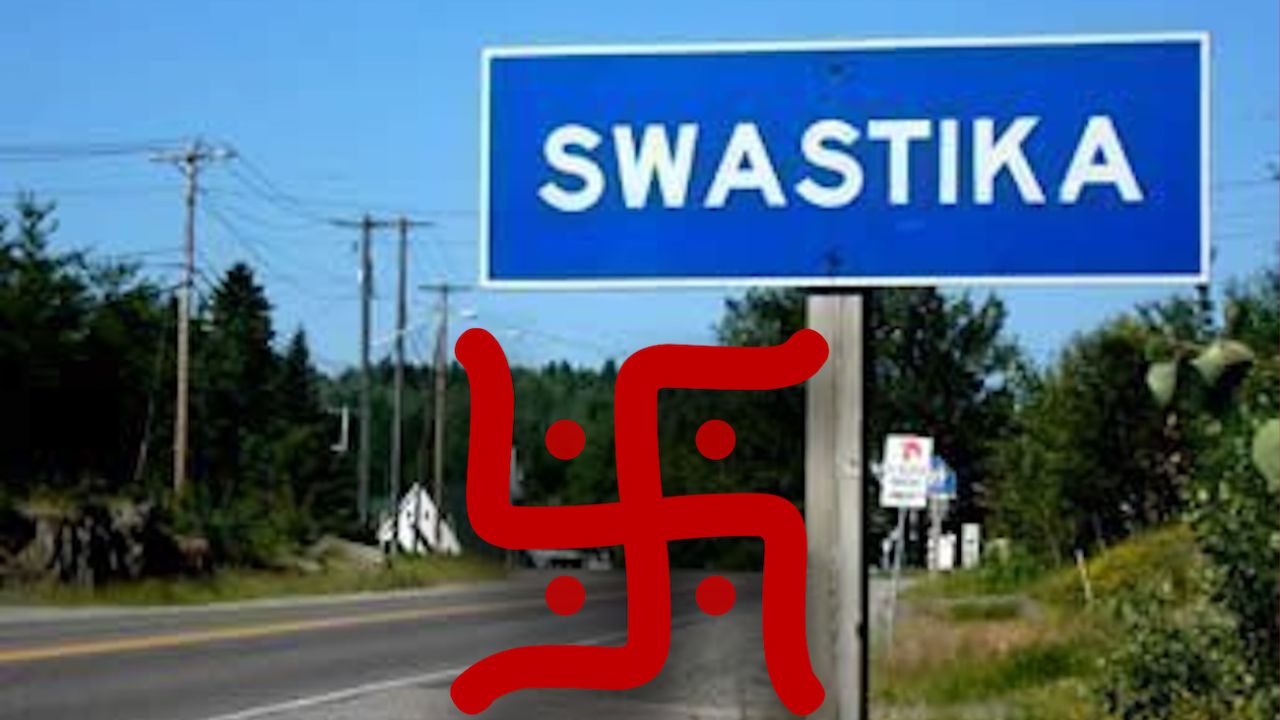“To hell with Hitler; we had the Swastika first.”
In 1935, at the height of a world darkened by war, this defiant message echoed from a small mining town in Canada named Swastika. When the provincial government attempted to rename the town “Winston” — a symbolic gesture of wartime patriotism — the residents responded with unmistakable clarity. They tore down the new sign, reinstated their original, and added another for emphasis. Their stance wasn’t about politics. It was about protecting a name and a symbol that carried a far older, sacred meaning.
The Swastika, for thousands of years, has symbolized peace, prosperity, and well-being in Hinduism, Buddhism, Jainism, and among Indigenous communities. Long before the Nazis appropriated and corrupted it into the Hakenkreuz, it was — and still is — a revered Dharmik symbol.
Today, nearly a century after that moment of defiance, the fight to protect and reclaim the Swastika continues across Canada — not just in public debates, but in classrooms, legislative halls, courtrooms, and the quiet corners of Canadian homes.
A Sacred Symbol Lost in Translation
The debate came into sharp focus in Puslinch, Ontario, where a private road named Swastika Trail, dating back before World War II, became the center of a heated controversy. Some residents wanted the name erased, while others defended its original, peaceful meaning. In 2019, after a long legal battle, the Ontario Divisional Court upheld the decision to keep the name — a symbolic victory for cultural clarity over historical amnesia.
But the episode exposed a deeper problem: the widespread failure to distinguish between the Swastika — an ancient spiritual emblem — and the Nazi Hakenkreuz, a symbol of unimaginable hatred and genocide.
Canada Once Knew This Symbol
The Swastika wasn’t always misunderstood in the West. In fact, Canadian cities are filled with reminders of its once widely recognized positive meaning. From brickwork on Montreal apartment buildings to the facade of the historic Traveller’s Hotel in Ladysmith, B.C., the Swastika adorned public spaces as a motif of good fortune.
The story also intertwines with Indigenous history. In 1940, under intense wartime pressure, several Indigenous nations — including the Navajo, Apache, Hopi, and Pueblo — signed a resolution agreeing to stop using the Swastika in their art and cultural expressions. This was not out of shame, but due to power imbalance and global trauma they did not create.
Today, through efforts like Canada’s Truth and Reconciliation movement, Indigenous communities are beginning to reclaim their languages, ceremonies, and sacred symbols, including the whirling log (Swastika). For them, reintroducing this imagery is both an act of decolonization and cultural sovereignty — though not without challenges and criticism.
For Hindu, Buddhist, and Jain Communities: A Living Identity
Unlike many others, Hindus, Buddhists, and Jains have continued to use the Swastika uninterrupted in daily rituals, temple walls, wedding ceremonies, festivals, and even children’s names. It remains a living part of Dharmik identity.
For nearly a million Hindu Canadians, the Swastika is not a relic of the past — it is a sacred, everyday reality. And yet, their devotion is often met with misunderstanding and fear.
- In Quebec, a Hindu worship marker on an anchor was mistaken for a Nazi relic.
- In Orillia, police were called to investigate what turned out to be a religious symbol of prosperity.
- In Richmond, B.C., toy pandas were pulled from shelves over innocent decorative motifs.
Around the world, the stigma follows: a woman named Swastika was banned from Uber in Australia. A UK caretaker was fired over a Swastika tattoo. A Jewish student in Washington, D.C., who brought home a Swastika from India as a symbol of peace, was suspended as if he had embraced hate.
This confusion isn’t harmless. It silences communities, marginalizes faiths, and erases centuries of sacred meaning.
Learning from Global Examples
Canada does not need to invent the solution from scratch. In Australia, states like Victoria and New South Wales have enacted laws banning Nazi symbols while explicitly protecting the Swastika for religious and cultural use. Their legal framework is clear: ban the Hakenkreuz, not the Swastika.
Even Jewish organizations, including B’nai Brith Canada and the Israeli Embassy, have publicly recognized this critical distinction. Influential voices like Steven Heller, who once called the Swastika “irredeemable,” have evolved their views — advocating for an accurate separation between a hate symbol and a sacred one.
Bill C-9 and the Fight for Clarity
Canada’s proposed Bill C-9 (Combatting Hate Act) seeks to address rising hate crimes. While well-intentioned, its vague language risks conflating the Swastika with the Nazi Hakenkreuz, endangering the religious freedom of Hindu, Buddhist, Jain, and Indigenous communities.
As legal advocates and cultural leaders have pointed out, legislation must be precise — protecting both Holocaust remembrance and Dharmik identity.
True Solidarity Requires Nuance
We must hold two truths together:
- The Nazi Hakenkreuz is a symbol of horror — representing the Holocaust’s unparalleled trauma. It must be condemned without compromise.
- The Swastika is sacred — a symbol of peace, divinity, and cultural identity for billions of people worldwide.
Protecting one does not diminish the other. In fact, distinguishing between the two strengthens our collective moral clarity.
The Path Forward: Moral Clarity, Not Historical Amnesia
This is more than a legal debate — it’s a test of Canada’s inclusivity. By making clear distinctions, we can honor Holocaust survivors while protecting Dharmik and Indigenous identities. We can confront hate without erasing sacred history.
Just as the people of Swastika, Ontario, stood firm in 1935, we must do the same today:
👉 To hell with Hitler.
👉 The Swastika is sacred.
👉 Ban the Hakenkreuz — not a symbol of peace.
✨ Cultural preservation and justice are not opposites — they are allies.
Source: Americankahani


